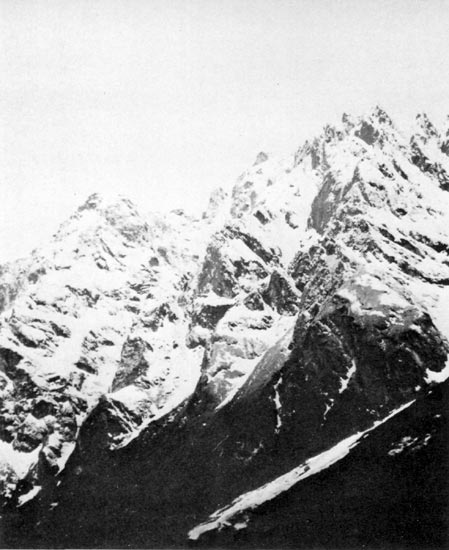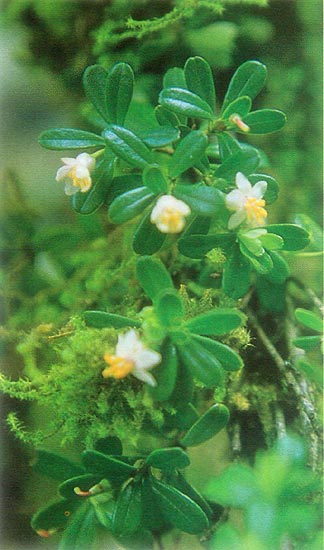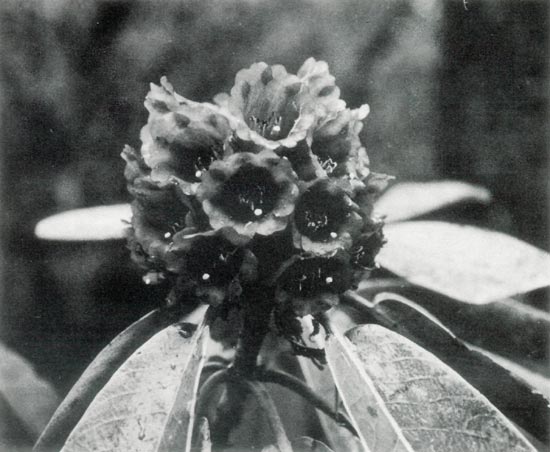JARS v44n4 - The Pradhan-Lachungpa Rhododendron Expeditions to Northeast Sikkim
The Pradhan-Lachungpa Rhododendron Expeditions to Northeast Sikkim
Udai C. Pradhan
Kalimpong, West Bengal, India
From orchids to rhododendrons is a long journey - particularly in a world of specialization where even friends raise their eyebrows and begin to make odd remarks when they hear of someone jumping from an interest in orchids to one in rhododendrons. But human interest is a peculiar motivation - a driving force that unlocks the doors to knowledge and provides sublime satisfaction. Having completed my two volume work on Indian orchids in 1979, I decided that for a change and in between work on the revision of the orchid family, I would look afresh at our local alpine flora, botanically, historically and horticulturally, and leave behind accounts that would focus attention on their conservation and exploration - and at the same time provide a means to learn by doing. I appreciate the theory of learning by doing, a method in which I was trained from childhood to recall and know intimately through handling, over three hundred species of plants of the cactus family which had their origins in America and grew in my father's nursery. Similarly, my early interest in the orchid family has helped me to tuck away in my natural memory bank over eight hundred species of Indian orchids, most of which I know from first hand experience.

|
|
Mountains above Yumthang where we
discovered R. pumilum Photo by Udai Pradhan |
In 1980, I planned my first expedition to the Singalila Mountains bordering Darjeeling, Sikkim and Nepal in the company of Bhaktiman Rai who had collected for the Lloyd's Botanic Garden, Darjeeling, for three decades. This trip lasted for one month and provided me and my wife, Tej, with the stimulus to found the Himalayan Plant Journal . (See "Summer Flora of Singalila Mountains" - Himalayan Plant Journal Volume 1 (2) - Volume 3 (7), 1982-1985.) In 1981, Mr. Oleg Polunin (coauthor with Adam Stainton - Flowers of the Himalaya , 1984), Mrs. Heather Salzen, and their party paid us a visit, which further strengthened our resolve.
The journal soon put us in touch with people around the world and Sonam Lachungpa, who had earlier been visiting me to obtain meri-cloned orchids from my laboratory became a close friend. In 1983 he became a supporting life subscriber to the Himalayan Plant Journal , the first Indian to do so. We decided to explore Sikkim together, and while he tackled northern Sikkim, I continued to work on the Darjeeling hills. Finally in 1985 we decided that a joint exploration was necessary for northeastern Sikkim which had remained out of bounds for foreign visitors for a long time. Since Sikkim was renowned for its rhododendrons we decided to make a beginning with rhododendron flora, as the local people too felt the need for an illustrated account. In 1986, we undertook four 7 to 10 day long trips during the rhododendron flowering season and two additional trips during the month of October and November along the ill-explored northeastern part of Sikkim. This was supplemented with further visits singly and jointly during 1987. While the findings are being published in book form, here is a brief summary of our book's contents and some of our observations.

|
|
R. vaccinioides
Photo by Udai Pradhan |
Since Sir Joseph Hooker's monumental work on Sikkim rhododendrons entitled The Rhododendrons of Sikkim-Himalaya that was published in 1849, no illustrated account or revision of Sikkim rhododendrons has been undertaken. In this account, he described forty-three species and illustrated thirty-two through drawings made in the field. Later in 1882, C.B. Clarke in Sir Joseph Hooker's Flora of British India enumerated forty-six species from the Indian region.
More recently, K. Biswas in Plants of Darjeeling and Sikkim-Himalaya Volume 1 (1966) describes twenty-eight species. A small book entitled Rhododendrons of Darjeeling and Sikkim-Himalayas written by M. Sain and published by Britt and Jean Smith, Kent, Washington, in 1974 describes thirty-six species. Though this is a very informative book, it does not provide illustrations or a field key. Professor H. Hara records twenty-four species in his Flora of Eastern Himalaya (1966), and Polunin and Stainton describe twenty-nine species in Flowers of the Himalaya (1984).
In our work on Sikkim rhododendrons we give the first field key for all known species, subspecies, natural hybrids and varieties. We also provide detailed sketches of winter buds and leaf configuration of nearly all of them enabling field identification even when the species is not in bloom. This should be of great use to seed collectors, botanists and conservationists.

|
|
Winter bud and leaf arrangement of
R. aeruginosum
, 3/4 natural size.
Drawing by Udai Pradhan |

|
|
Winter bud and leaf arrangement of
R. dalhousiae
, 3/4 natural size.
Drawing by Udai Pradhan |

|

|
|
|
Winter bud and leaf arrangement of R. campanulatum, 3/4 natural size.
Drawing by Udai Pradhan |
Winter bud and leaf arrangement of
R. fulgens
, 3/4 natural size.
Drawing by Udai Pradhan |
|

|

|
|
|
Winter bud and leaf arrangement of
R. niveum
, 3/4 natural size.
The related species of R. arboreum and R. niveum are often thought of as the same entity, but with different coloured flowers. The winter bud and leaf arrangement show that they are very distinct. The colour of the leaves are also very different. Drawing by Udai Pradhan |
Winter bud and leaf arrangement of
R. lindleyi
, 3/4 natural size.
Drawing by Udai Pradhan |
All species and natural hybrids (with the exception of R. micromeres ) are illustrated with field drawings of flowers and leaves in natural size, the first such record by native botanists, and supplemented further by field photographs. We provide field characteristics in layman's language, and give botanical descriptions. The history and origin of each species, local names and uses are traced. We include a distribution map of all species from Sikkim and the Darjeeling Himalaya area. Cultivation guidelines and information about the ecology and present status of the species in the wild are incorporated into the text.

|
|
R. aeruginosum
, Northeast Sikkim at 4,500 meters (14,760 feet)
Photo by Sonam Lachungpa |
Rhododendron aeruginosum is reinstated as a distinct species. We think all the recent literature took Sir Joseph Hooker's comparative statement in The Rhododendrons of Sikkim-Himalaya as the base for making R. aeruginosum a subspecies or variety of R. campanulatum . The uniform geographical population in northeastern Sikkim (we have not come across intermediates), the winter bud and leaf configuration, the petioles of the leaves which rise at an angle and the leaf-blade which proceeds nearly horizontally or at a slight angle, the slender cylindric fruits, the flower size, the thick rusty indumentum on the leaf underside, the verdigris blue of the new leaves, are characters enough to justify Sir Hooker's entity. Our illustrations and photographs support our position.

|
|
Rhododendron dalhousiae
ssp.
tashii
,
Pangthang area of Gangtok in eastern Sikkim Photo by Udai Pradhan |
The Rhododendron dalhousiae population in eastern Sikkim is very distinct and uniform, especially in its colour, which is pale lemon-green fading at maturity to sulphur yellow and tinged green. The vegetative structure is similar and even when not in flower this population can be identified as R. dalhousiae . Maybe this is the reason why no one cared to record it during flowering. Nowhere in eastern Sikkim did we come across R. dalhousiae with the usual white flowers. The corolla also is larger and more expanded. We have decided to give it a subspecific rank and call it R. dalhousiae subspecies tashii *.
*After the late Mr. Tse Ten Tashi of Gangtok, Sikkim, ardent wildlife photographer, who filled us with enthusiasm to study Sikkim plants during our teens. He was a keen orchid and rhododendron fancier and played a significant role in their conservation in Sikkim.
Those hybridisers seeking green colour in rhododendrons would do well to use this subspecies in their hybridising programme. Seeds from our expedition have been distributed to many individuals and institutions. Plants grown from this seed may now be close to flowering. An illustration of this subspecies is provided.
Rhododendron salignum and R. obovatum have been raised to sub-specific rank. Support for such a move is detailed in our book.
A new natural hybrid, possibly of
R. arboreum
and
R. thomsonii
is being named
R.
x
sikkimense
.
In all, fifty-two rhododendron specimens were collected on our expeditions for future reference and as a record of our field work. A set is already lodged for expert opinion at the Royal Botanic Garden, Edinburgh, Scotland. Duplicates after completion of the publication on Sikkim rhododendrons will be distributed to the Smithsonian, Kew and the Herbarium of the Indian Botanic Garden in Calcutta.

|
|
R. camelliiflorum
, growing near Nathula
at 2,800 meters (about 8,960 feet) Photo by Udai Pradhan |

|
|
R. niveum
, deep color form
Photo by Udai Pradhan |

|
|
Rhododendron campanulatum
, Northeastern Sikkim
Photo by Sonam Lachungpa |

|
|
R. hodgsonii
Photo by Udai Pradhan |
The proceeds from the book on Sikkim rhododendrons, after defraying publication costs will be utilised in giving the Himalayan Plant Journal a sound financial base so that it can continue to fund such expeditions. We are also planning a Himalayan garden in Kalimpong in an area of nearly thirteen acres put aside for this purpose. Later, when sufficient funds become available, we envisage forming a Himalayan plant trust that will oversee the gardens and continue the publication of the journal. Facilities for housing my library, herbarium, paintings and plant collections will have to be built along with a micro-propagation centre for rare Himalayan plants. We also desire to have facilities for training a small batch of dedicated hill youths who can later spearhead the trust and take an active part, worldwide, in the propagation and dissemination of knowledge on Himalayan plants. This is being done so that what we have left of our natural heritage may be conserved in a responsible manner for posterity.
Mr. Pradhan may be contacted by writing in care of The Himalayan Plant Journal Abhijit Villa, B.P.O. Ecchey, Kalimpong - 734301, Darjeeling Gorkha Hill Council, West Bengal, India.
(Editor's note: At this time, we have not been able to determine whether Mr. Pradhan's book has been published or is still in preparation.)
